Blood Screening Market Size
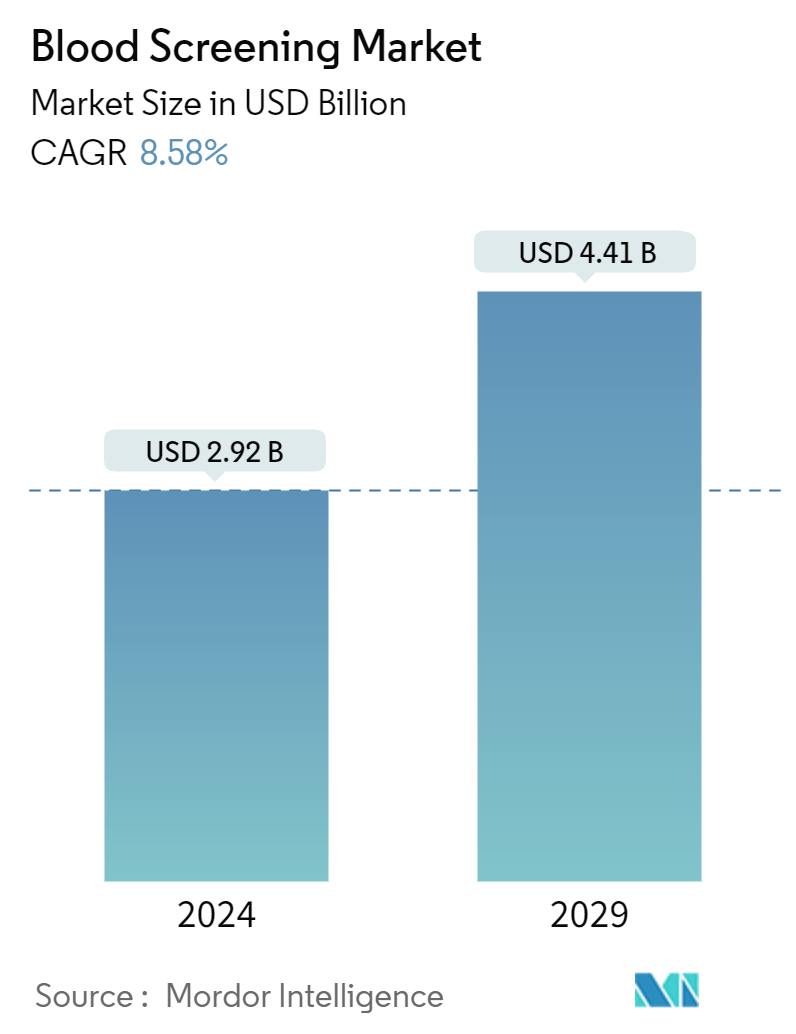
| Study Period | 2019 - 2029 |
| Market Size (2024) | USD 2.92 Billion |
| Market Size (2029) | USD 4.41 Billion |
| CAGR (2024 - 2029) | 8.58 % |
| Fastest Growing Market | North America |
| Largest Market | Asia Pacific |
| Market Concentration | Low |
Major Players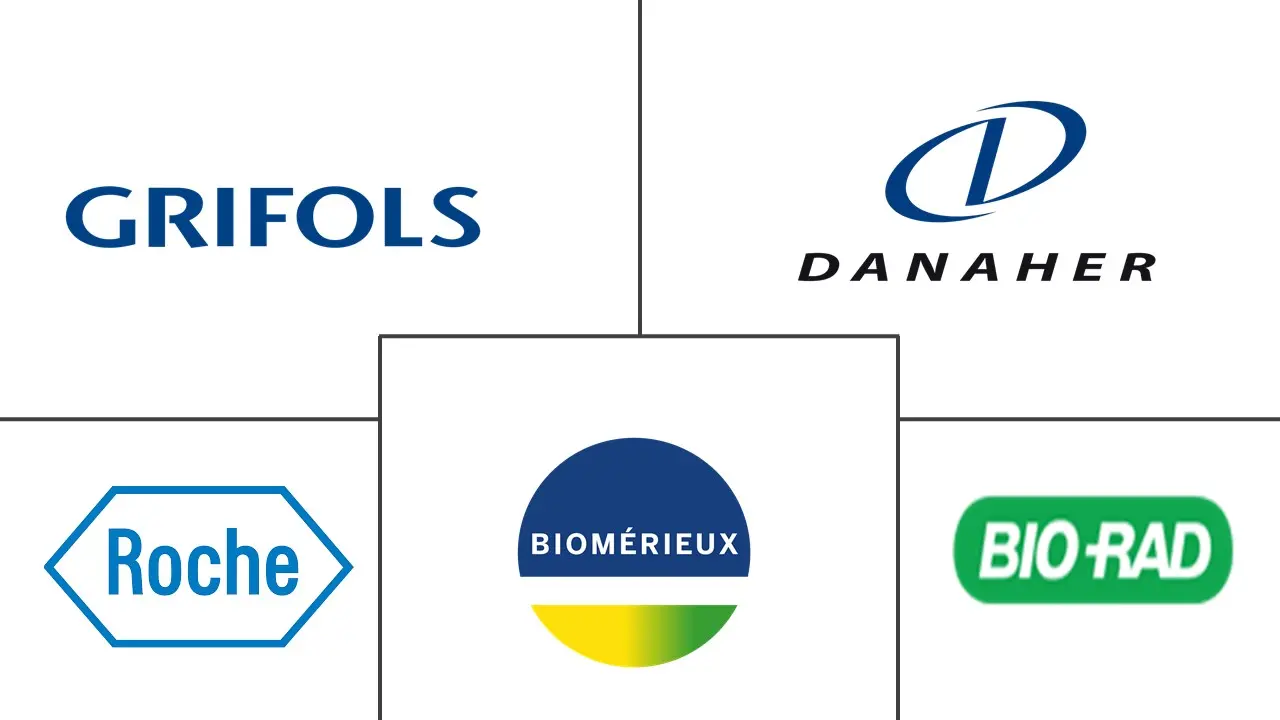
*Disclaimer: Major Players sorted in no particular order |
Blood Screening Market Analysis
The Blood Screening Market size is estimated at USD 2.92 billion in 2024, and is expected to reach USD 4.41 billion by 2029, growing at a CAGR of 8.58% during the forecast period (2024-2029).
- The blood screening market is a pivotal segment within the broader healthcare diagnostics industry, playing a crucial role in ensuring the safety of blood transfusions by detecting infections and other abnormalities. The increasing global demand for safe blood, combined with technological advancements in screening methods, is shaping the future of this market. This analysis delves into the trends, challenges, and future outlook of the blood screening market, highlighting the significance of this industry in the global healthcare landscape.
Technological Advancements and Market Growth
- Nucleic Acid Amplification Tests (NAT): Blood screening involves various techniques, including Nucleic Acid Amplification Tests (NAT), ELISA, and Next-Generation Sequencing (NGS), to detect pathogens like HIV, hepatitis, and other infectious agents. The adoption of advanced blood screening technologies has significantly enhanced the accuracy and speed of blood testing, reducing the risks associated with transfusions. As the global healthcare landscape increasingly focuses on precision medicine and patient safety, these technologies are becoming more integral to the blood screening industry.
- ELISA and NGS Technologies: The evolution of Enzyme-Linked Immunosorbent Assay (ELISA) and Next-Generation Sequencing (NGS) technologies has revolutionized blood screening, allowing for the detection of a broader range of pathogens with greater sensitivity. These advancements have driven the demand for more sophisticated blood screening assays, contributing to the market's expansion. The continued innovation in these technologies is expected to further enhance the capabilities of blood screening diagnostics, supporting industry growth.
- Automation in Blood Screening: Automation has become a key trend in the blood screening market, improving efficiency and reducing human error in laboratories. The integration of automated systems in blood screening processes has not only increased throughput but also enhanced the accuracy of results. This trend is particularly relevant in regions with advanced healthcare infrastructure, where the demand for reliable and high-throughput screening solutions is high. Automation is likely to remain a significant driver of market growth, as laboratories continue to seek ways to improve their operational efficiency.
Strengthening Blood Safety Amid Rising Donations
- Increasing Number of Blood Donations and Transfusion-Related Screenings: The global increase in blood donations is a key factor driving the blood screening market. With more people donating blood, there is a growing need for robust screening processes to ensure the safety of the blood supply. Blood banks and healthcare facilities are implementing advanced screening techniques to handle the higher volume of donations. This trend is particularly evident in regions with strong government support for blood donation programs, where increased public awareness and improved infrastructure have contributed to higher donation rates. As the volume of donations rises, so does the demand for cutting-edge blood screening assays, which are critical in identifying infectious agents and ensuring that transfused blood is safe for recipients.
- Growing Prevalence of Infectious Diseases: The spread of infectious diseases continues to be a significant concern for public health, particularly in regions with limited access to advanced healthcare. The growing incidence of diseases such as HIV, hepatitis B and C, and Zika virus has underscored the need for more stringent blood screening protocols. Governments and healthcare organizations are prioritizing the implementation of comprehensive screening technologies to mitigate the risk of transmitting these infections through blood transfusions. This has led to increased adoption of nucleic acid amplification tests (NAT), chemiluminescence immunoassays (CLIA), and other high-sensitivity techniques in blood screening laboratories. The focus on preventing the spread of infectious diseases through transfusions is driving continuous innovation in blood screening technologies, ensuring that the market remains dynamic and responsive to emerging health challenges.
Challenges in the Evolving Diagnostic Landscape
- Development of Alternative Technologies: The emergence of alternative diagnostic technologies poses a challenge to the traditional blood screening market. Innovations such as point-of-care testing and advanced molecular diagnostics are increasingly being explored as substitutes for conventional blood screening methods. These technologies offer the potential for quicker, more accessible diagnostic solutions, potentially reducing the reliance on centralized blood screening systems. As a result, traditional blood screening companies may face competition from new entrants offering alternative solutions that promise greater convenience and cost-effectiveness. To remain competitive, established blood screening companies must continue to innovate and integrate new technologies into their offerings.
- Lack of Legislation, Regulations, and Policies: In many regions, the absence of comprehensive legislation and regulatory frameworks governing blood screening practices remains a significant barrier to market growth. The lack of standardized policies can lead to inconsistencies in screening procedures, compromising the safety of blood transfusions. This issue is particularly pronounced in low- and middle-income countries, where healthcare infrastructure may be underdeveloped, and regulatory oversight is limited. The absence of clear guidelines can result in gaps in blood safety, putting patients at risk. To address this challenge, international health organizations and local governments must collaborate to establish and enforce robust regulatory frameworks that ensure the consistent and safe application of blood screening technologies.
Blood Screening Market Trends
Reagent Segment is Expected to Hold Significant Market Share Over the Forecast Period
- Reagent Segment to Dominate the Blood Screening Market: The reagent segment is anticipated to maintain its dominance in the blood screening market due to the rising demand for accurate diagnostic assays. Reagents, essential for detecting infectious diseases like HIV, hepatitis, and syphilis, have seen increased usage, driven by the global burden of these diseases. For example, as the WHO's 2022 Global Tuberculosis Report noted, TB cases rose to 10.6 million in 2021, underscoring the growing need for effective blood screening reagents.
- Furthermore, innovations in molecular assays and next-generation sequencing (NGS) have enhanced the sensitivity of blood screening technologies, leading to higher adoption rates in laboratories. This segment's growth is also bolstered by the automation of blood screening processes, which increases efficiency and reduces human error, making reagents even more critical.
- Technological Advancements Propel the Reagent Market: Advancements in blood screening technologies, particularly in molecular assays and NGS, have significantly improved diagnostic accuracy, further driving the reagent market's expansion. Companies are increasingly adopting these advanced techniques to enhance early disease detection capabilities, which has increased the demand for high-quality reagents. Automation in blood screening has also played a crucial role in the reagent segment's growth, streamlining processes and improving throughput in laboratories.
- In addition, stringent regulatory requirements ensure the development of reliable and effective reagents, pushing manufacturers to innovate continuously and comply with industry standards, thereby strengthening the market position of this segment.
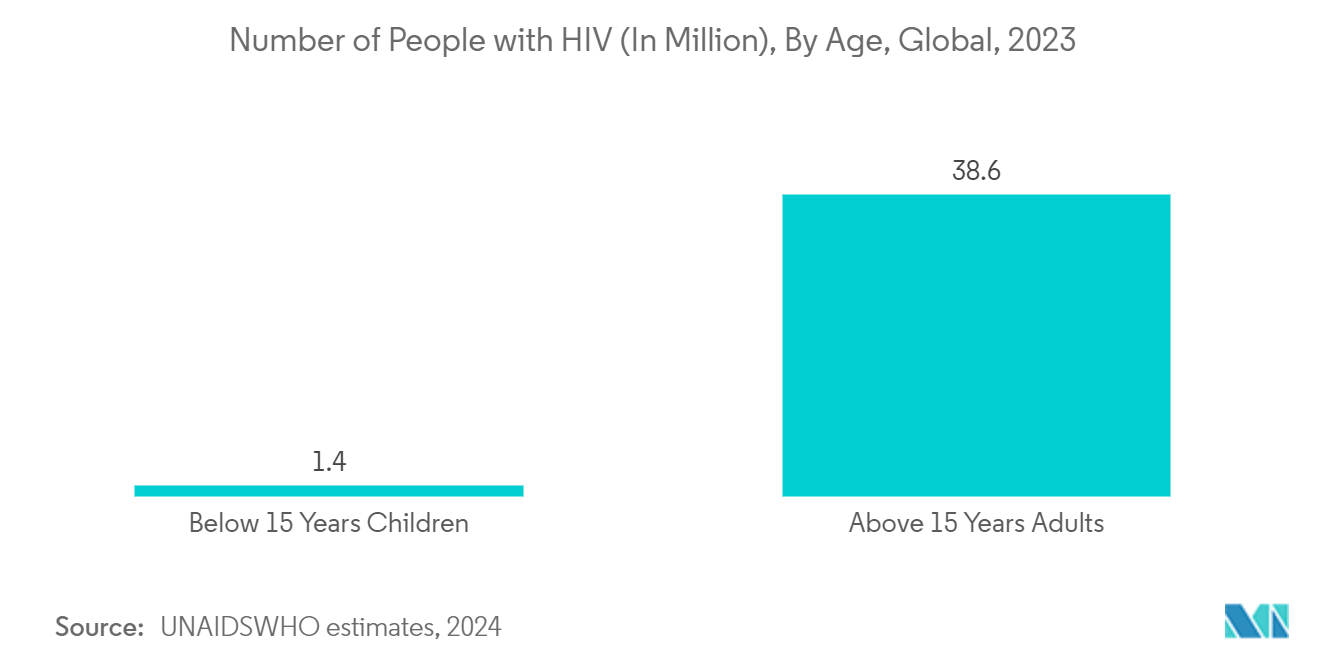
North America Holds a Significant Share in the Market and Expected to do Same during the Forecast Period
- Advanced Healthcare Infrastructure: North America is expected to continue leading the global blood screening market, driven by factors such as advanced healthcare infrastructure, significant healthcare spending, and high adoption of cutting-edge blood screening technologies. The United States, in particular, sees a high volume of blood donations and transfusions, with the American Red Cross estimating a daily need for 36,000 units of red blood cells. This high demand for blood supply underscores the necessity of effective blood screening technologies, further boosting market growth in the region.
- North America's stringent regulatory landscape also plays a vital role, ensuring that blood screening diagnostics meet high safety and efficacy standards, which encourages ongoing investment in research and development.
- Infectious Disease Prevalence Driving Market Growth: The rising prevalence of infectious diseases in North America significantly contributes to the growth of the blood screening market. For example, the US Department of Health & Human Services reported in 2022 that approximately 1.2 million Americans live with HIV, highlighting the ongoing need for reliable blood screening. This growing disease burden has led to an increased demand for blood screening diagnostics, further driving market expansion.
- Additionally, product innovations, such as the Galleri blood test launched by Grail in 2021, which can detect multiple cancers, illustrate the region's commitment to advancing blood screening technologies, reinforcing North America's dominant market position.
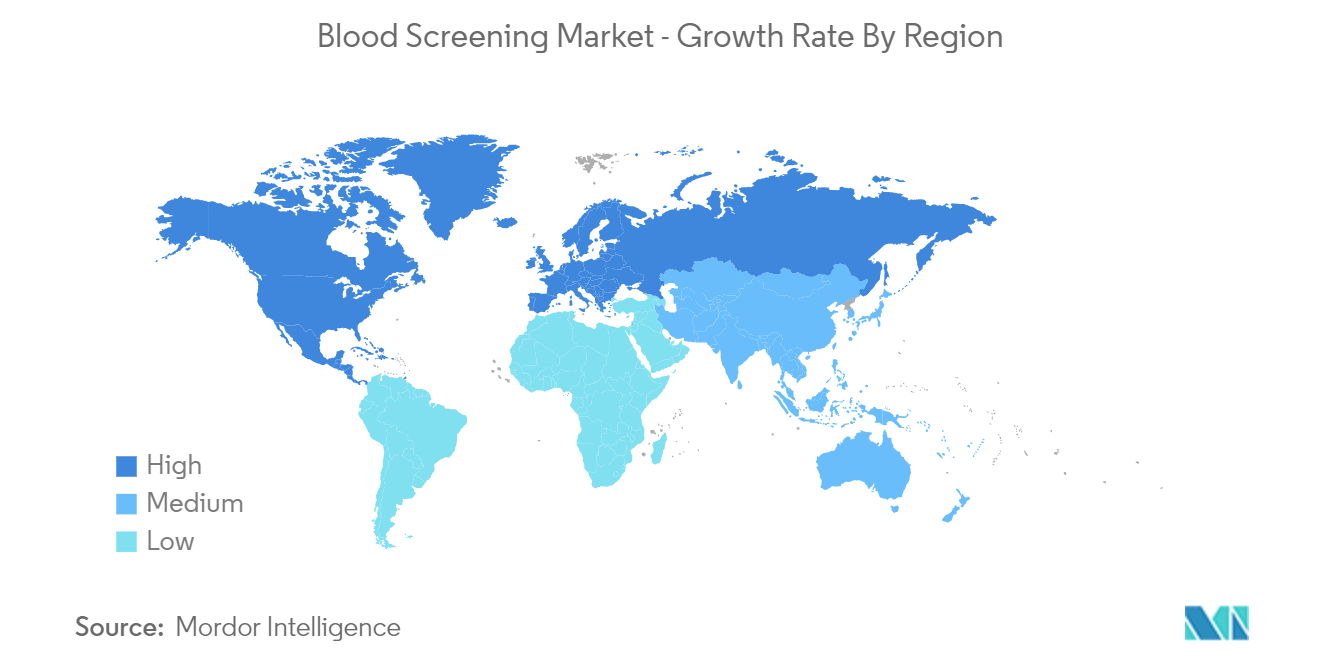
Blood Screening Industry Overview
- Fragmented Market with Diverse Players: The blood screening market is highly fragmented, with a mix of global giants and specialized companies competing for market share. This fragmentation indicates a broad array of companies, each offering distinct products and solutions. While a few large corporations dominate in terms of market presence and brand recognition, numerous smaller and mid-sized firms contribute to the diverse competitive landscape. This varied market structure fosters innovation and offers opportunities for new entrants, though competition remains intense across all segments.
- Market Leaders Driving Innovation: Major players such as F. Hoffmann-La Roche Ltd., Grifols, bioMérieux, Bio-Rad Laboratories, Inc., and Danaher Corporation are at the forefront of the blood screening market. These companies are recognized for their extensive portfolios, global reach, and robust research and development capabilities. They focus on advanced diagnostic technologies, improving the sensitivity and specificity of blood screening tests, and expanding their product lines to cater to emerging.
- Key Strategies for Future Success: In the fragmented blood screening market, success hinges on innovation, adaptability, and strategic partnerships. Companies that invest in advanced technologies, such as molecular diagnostics and automated screening systems, are likely to lead the market. Additionally, expanding global reach, particularly in emerging markets, and forming partnerships with healthcare providers and governments are critical strategies. Maintaining a competitive edge will also require a focus on regulatory compliance and addressing the growing demand for point-of-care testing.
Blood Screening Market Leaders
-
F. Hoffmann-La Roche Ltd.
-
Grifols
-
bioMérieux
-
Bio-Rad Laboratories, Inc.
-
Danaher Corporation
*Disclaimer: Major Players sorted in no particular order
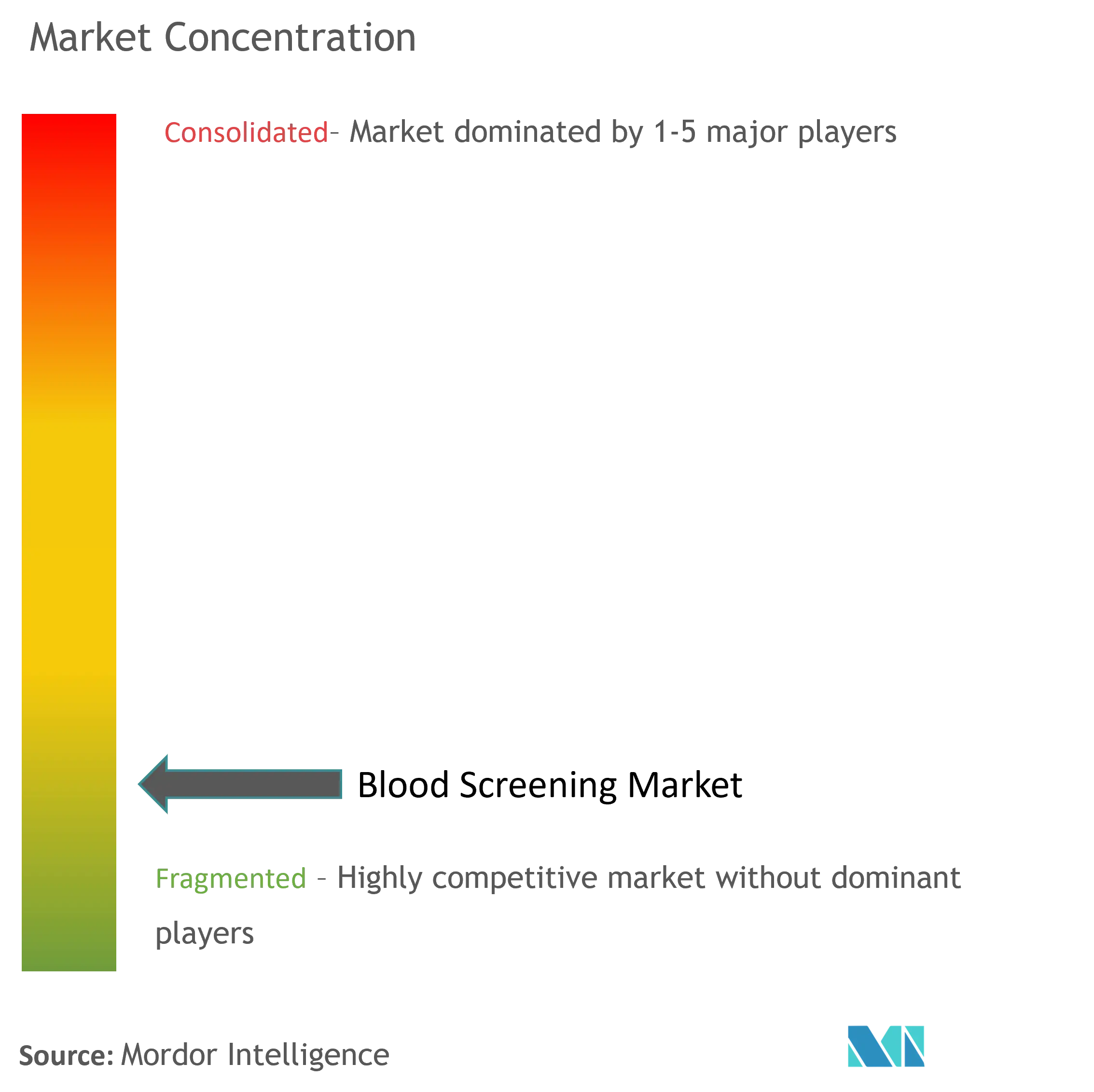
Blood Screening Market News
- In June 2024, Illumina Inc successfully integrated its latest chemistry, XLEAP-SBS, into all reagents for its NextSeq 1000 and NextSeq 2000 next-generation sequencing (NGS) instruments.
- In February 2024, Dyadic International Inc. teamed up with Cygnus Technologies, a division of Maravai LifeSciences, to quantify Host Cell Proteins (HCP) from the patented C1-cells of the filamentous fungus, Thermothelomyces heterothallica (previously known as Myceliophthora thermophila). As per the partnership agreement, Cygnus created the C1 HCP ELISA Kit, which will be offered to customers of both Dyadic and Cygnus.
Blood Screening Market Report - Table of Contents
1. INTRODUCTION
1.1 Study Assumptions and Market Definition
1.2 Scope of the Study
2. RESEARCH METHODOLOGY
3. EXECUTIVE SUMMARY
4. MARKET DYNAMICS
4.1 Market Overview
4.2 Market Drivers
4.2.1 Increasing Number of Blood Donations and Transfusion Related Screenings
4.2.2 Growing Prevalence of Infectious Diseases
4.2.3 Increasing Government Initiatives
4.3 Market Restraints
4.3.1 Development of Alternative Technologies
4.3.2 Lack of Legislation, Regulations, and Policies
4.4 Porter's Five Forces Analysis
4.4.1 Bargaining Power of Suppliers
4.4.2 Bargaining Power of Buyers/Consumers
4.4.3 Threat of New Entrants
4.4.4 Threat of Substitute Products
4.4.5 Intensity of Competitive Rivalry
5. MARKET SEGMENTATION (Market Size by Value - USD)
5.1 By Product
5.1.1 Reagents
5.1.2 Instruments
5.2 By Technology
5.2.1 Nucleic Acid Amplification Test (NAT)
5.2.2 Enzyme-linked Immunosorbent Assay (ELISA)
5.2.3 Chemiluminescence Immunoassay (CLIA) and Enzyme Immunoassay (EIA)
5.2.4 Next-Generation Sequencing (NGS)
5.2.5 Western Blotting
5.3 By End-User
5.3.1 Blood Banks
5.3.2 Hospitals
5.3.3 Clinical laboratories
5.4 Geography
5.4.1 North America
5.4.1.1 United states
5.4.1.2 Canada
5.4.1.3 Mexico
5.4.2 Europe
5.4.2.1 Germany
5.4.2.2 United Kingdom
5.4.2.3 France
5.4.2.4 Italy
5.4.2.5 Spain
5.4.2.6 Rest of Europe
5.4.3 Asia-Pacific
5.4.3.1 China
5.4.3.2 Japan
5.4.3.3 India
5.4.3.4 Australia
5.4.3.5 South Korea
5.4.3.6 Rest of Asia-Pacific
5.4.4 Middle East and Africa
5.4.4.1 GCC
5.4.4.2 South Africa
5.4.4.3 Rest of Middle East and Africa
5.4.5 South America
5.4.5.1 Brazil
5.4.5.2 Argentina
5.4.5.3 Rest of South America
6. COMPETITIVE LANDSCAPE
6.1 Company Profiles
6.1.1 F. Hoffmann-La Roche Ltd.
6.1.2 Grifols
6.1.3 Abbott Laboratories, Inc.
6.1.4 bioMerieux Inc.
6.1.5 Bio-Rad Laboratories, Inc.
6.1.6 Becton, Dickinson and Company
6.1.7 Danaher Corporation
6.1.8 DiaSorin S.P.A
6.1.9 Siemens Healthineers
6.1.10 Thermo Fisher Scientific, Inc.
6.1.11 Ortho Clinical Diagnostics Inc.
6.1.12 PerkinElmer Inc.
- *List Not Exhaustive
7. MARKET OPPORTUNITIES AND FUTURE TRENDS
Blood Screening Industry Segmentation
As per the scope of the report, a blood screening is a laboratory test done on a blood sample taken from a vein in the arm using a hypodermic needle or a fingerprick. Blood screening aims to detect infection markers so that infected blood and blood components are not released for clinical use.
The blood screening market is segmented by product, technology, end user, and geography. By product, the market is segmented into reagents and instruments. By technology, the market is segmented into nucleic acid amplification test (NAT), enzyme-linked immunosorbent assay (ELISA), chemiluminescence immunoassay (CLIA), and enzyme immunoassay (EIA), next-generation sequencing (NGS), and western blotting. By end user, the market is segmented into blood banks, hospitals, and clinical laboratories. By geography, the market is segmented into North America, Europe, Asia-Pacific, the Middle East and Africa, and South America. The report also covers the estimated market sizes and trends for 17 countries across major regions globally. The report offers the value (in USD) for the above segments.
| By Product | |
| Reagents | |
| Instruments |
| By Technology | |
| Nucleic Acid Amplification Test (NAT) | |
| Enzyme-linked Immunosorbent Assay (ELISA) | |
| Chemiluminescence Immunoassay (CLIA) and Enzyme Immunoassay (EIA) | |
| Next-Generation Sequencing (NGS) | |
| Western Blotting |
| By End-User | |
| Blood Banks | |
| Hospitals | |
| Clinical laboratories |
| Geography | ||||||||
| ||||||||
| ||||||||
| ||||||||
| ||||||||
|
Blood Screening Market Research FAQs
How big is the Blood Screening Market?
The Blood Screening Market size is expected to reach USD 2.92 billion in 2024 and grow at a CAGR of 8.58% to reach USD 4.41 billion by 2029.
What is the current Blood Screening Market size?
In 2024, the Blood Screening Market size is expected to reach USD 2.92 billion.
Who are the key players in Blood Screening Market?
F. Hoffmann-La Roche Ltd., Grifols, bioMérieux, Bio-Rad Laboratories, Inc. and Danaher Corporation are the major companies operating in the Blood Screening Market.
Which is the fastest growing region in Blood Screening Market?
North America is estimated to grow at the highest CAGR over the forecast period (2024-2029).
Which region has the biggest share in Blood Screening Market?
In 2024, the Asia Pacific accounts for the largest market share in Blood Screening Market.
What years does this Blood Screening Market cover, and what was the market size in 2023?
In 2023, the Blood Screening Market size was estimated at USD 2.67 billion. The report covers the Blood Screening Market historical market size for years: 2019, 2020, 2021, 2022 and 2023. The report also forecasts the Blood Screening Market size for years: 2024, 2025, 2026, 2027, 2028 and 2029.
Blood Screening Industry Report
Our industry research and consulting expertise in the blood screening market encompass a comprehensive analysis of the latest trends, technological advancements, and market dynamics shaping this critical segment of healthcare diagnostics. The report delves into key areas such as the adoption of cutting-edge blood screening technologies like Nucleic Acid Amplification Tests (NAT), ELISA, and Next-Generation Sequencing (NGS), which are instrumental in enhancing the accuracy and speed of blood testing. Additionally, the report explores the growing automation in blood screening processes, which is driving efficiency and reducing errors in laboratories. By providing in-depth insights and detailed data, stakeholders can leverage this information to make informed decisions, optimize their strategies, and stay ahead in a rapidly evolving market.
The blood screening market research report covers critical aspects such as market segmentation, regional analysis, and the competitive landscape, offering a holistic view of the industry's future outlook. The report also highlights the regulatory landscape and the challenges posed by the emergence of alternative diagnostic technologies. With the increasing prevalence of infectious diseases and the rising number of blood donations, our report pdf provides valuable insights into the industry's growth opportunities and potential risks. Stakeholders, including healthcare providers, diagnostic companies, and investors, can benefit from this analysis by gaining a deeper understanding of market drivers and trends, enabling them to navigate the complexities of the blood screening market effectively.
Statistics for the 2024 Blood Screening market share, size and revenue growth rate, created by Mordor Intelligence™ Industry Reports. Blood Screening analysis includes a market forecast outlook to 2029 and historical overview. Get a sample of this industry analysis as a free report PDF download.



